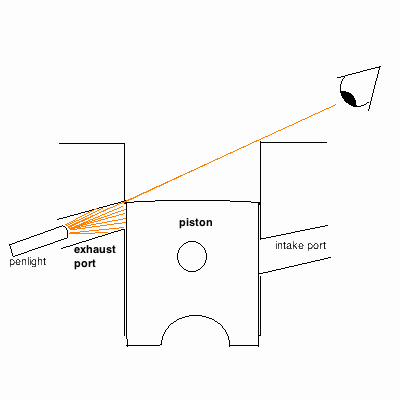Measuring Port Durations
USING A PORT TIMING CALCULATOR
This method is only accurate if there is no vertical piston play due to worn loweer connecting rod bearing. If there is no play then this is the best method because the method below gets thrown off by the chamfer at the top edges of ports. Hardest part of this method is measuring the deck (distance from top edge of piston to top edge of cylinder when the piston is at TDC) when there's no space for your digital caliper. I have to rotate the gas tank to the right to get enough space. "Deck" distance is positive when the top piston edge is below the top edge of the cylinder, and negative when it is above the cylinder (which happens sometimes after lathing off metal from the bottom of the cylinder, using a taller non-stock piston, or from lathing off cylinder top for more compression). Measure distances from the top of the cylinder to the "ghost" edge of the cylinder. It is lower then the real edge when there is a chamfer (30 degree angle to keep rings from catching on the edge). You have to look at the angle of the top surface of the port and mentally extend that same surface out to where it would meet the piston/rings.
USING A DEGREE WHEEL
I don't recommend using a degree wheel in a way that depends on
establishing top dead center. There's too many degrees that the piston
is at the very top. You can print out one of the wheels from here
, cut it out, and
cut a hole in the center that helps with centering it. Use silicone
seal to glue it to the left side crank shaft, let it dry an hour, take
the cylinder head and exhaust pipe off, shine a flashlight into the
exhaust port while looking at a low angle (see drawing below) for the
light.
With the degree wheel overlapping the countershaft sprocket cover, put a mark on the cover right at the edge of the degree wheel. Rotate
the crank so that the piston edge is above the port you want to degree.
Push down lightly on the piston with your finger while turning the
crank till to top of the port is equal to the top edge of the piston.
That pressure prevents any slop in the bearings from throwing the
measurement off. There is normally pressure on the descending piston
when running, which is what you're now simulating. Turn the crank till
the piston is descending. Mark the
degree wheel at the point which you can begin to see light. Turn the
crank more until the light is just blocked off
by the ascending piston and mark the degree wheel again. Determine the
number
of degrees between the two marks. Standard is around 140 degrees. This
is called the port duration, the number of degrees that the port is
open. Now do the same for the transfer ports but shine the light onto
the port from above and note when the dark
port top just becomes level with the piston top. To measure the intake
port duration you'll need to remove the intake manifold. The piston
needs to be traveling upwards for the first measurement and then
downwards (with your finger pressing onto the piston top) for the
second. A reed valve setup with holes in the piston does not need to be
measured since intake starts to flow in as soon as there's a vacuum
beneath the piston. At all rpm's up to 5000 this happens immediately
after BDC. It happens 5 degrees later for each 1000 rpm higher than
5000. At 8000 rpm it happens at 15 degrees after BDC.

|
